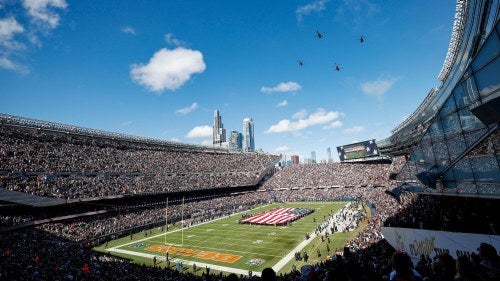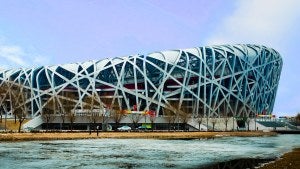How are sports stadiums funded globally, and what does it mean for Chicago?

For Chicago's sports stadiums, the financing debate between public funds and private investment remains an obstacle, as it has been for stadiums around the world.
Chicago could be getting two new sports stadiums.
Both the Chicago Bears and Chicago White Sox owners have sought permission to build new venues in the city in recent months. Following years of negotiations with suburban Arlington Heights, including the purchase of property for a stadium site, the Bears have recently shifted to a new proposal that would seek to build a stadium on the Chicago lakefront near Soldier Field. The White Sox, meanwhile, have proposed a new stadium for the South Loop.
In Chicago and around the world, the question of whether new stadiums ultimately get the green light often comes down to how they are financed. Global cities like Beijing, Munich, and Paris all have examples of stadiums supported by public financing, a funding model justified in part by the facilities’ use in hosting global events like the Olympics or the FIFA World Cup.

Stade de France, located just outside Paris, is supported by public funding for its construction and maintenance.

Substantial public funding was used to construct the Beijing National Stadium, commonly known as the Bird's Nest.
Using taxpayer money to fund stadiums can be controversial, particularly given the great wealth usually associated with professional sports teams and their owners. But it can have benefits, too, since public funding often comes with stipulations requiring improvements to the area surrounding a stadium in addition to the basic facility construction — a trade-off that isn’t always required if a team finances its stadium privately. This interplay between private and public funding may come up in the planning of Chicago’s potential new stadiums, since their immense cost means they’ll likely require a balance of private and public funds to break ground.
In the case of the White Sox, owner Jerry Reinsdorf has reportedly prepared a request for $1 billion in state funds to help pay for the stadium. No specific amount of public money has been floated for the Bears’ stadium build, but given that just $2 billion in private funding is being proposed while the stadium is likely to cost some multiple of that amount, a sizable amount of funding would likely fall on the taxpayer
How have stadiums in global cities been financed?
Stadiums can be financed in a number of ways. Emirates Stadium, home of Arsenal Football Club in London, for example, received no subsidy from the U.K. government, much to the chagrin of Arsenal’s then-manager.
Instead, the stadium was financed privately. Construction of the facility was billed as a long-term financial necessity to grow revenue for the club by nearly doubling seating capacity, and Arsenal’s ownership sought funding for it through a mix of tactics. For example, Arsenal traded away some of its best players, including fan favorites, for a profit. It also signed new sponsorship deals (including naming rights and jersey sponsorships), took out a £300 million loan with the Royal Bank of Scotland, and even offered a bond scheme with fans. In all, the stadium cost £390 million, and Arsenal’s on-field product was weakened in the short term to finance it.
That said, most stadiums receive at least some level of public financing. In fact, many stadiums built for global purposes like Olympic Games or the FIFA World Cup, such as Beijing National Stadium (also known as the Bird’s Nest), Stade de France outside Paris, and Estadio Olimpico Universitario in Mexico City, receive significant government funding. For example, 58% of the Bird’s Nest’s financing came from the Beijing Municipal Government.
Germany’s Allianz Arena, which is home to the Bayern Munich football club and has hosted FIFA and UEFA events, received a mix of public and private financing. Bayern Munich (along with another team originally slated to use the facility) privately financed the €340 million construction of the stadium itself, the cost of which was paid off within just nine years of construction — 16 years ahead of schedule. However, the government incurred costs of €210 million for development and infrastructure projects in the area surrounding the stadium, including transportation improvements.
What benefits come with public funding?
Charles Johnson and Brandon Dowling, CEO and principal, respectively, of real estate, convention, hospitality, and sports consulting firm C.H. Johnson Consulting, told ChicagoGlobal that stadium funding has changed in recent years to include broader development projects.
It used to be that a stadium was seen as a standalone proposition that adjacent development would simply grow around organically at some point in the future. “Now,” explained Dowling, “it’s sort of morphed into this district of ancillary development that’s incorporated with the new development.”
Dowling said that public financing is often a gap-closing measure in general with stadium builds, but he added that that’s especially true for ancillary development costs. The price of development around a stadium — pedestrian access areas, dining and retail real estate surrounding the facility, and the like — can be high in urban areas like downtown Chicago, but these ancillary projects can offer significant benefits to the local economy as neighborhoods are developed into multi-use districts.
"One of the more exciting things I’ve seen nowadays is this incorporation of sports and entertainment into mixed-used districts around it"
New stadiums have always come with an implicit promise of financial benefits for the neighborhoods and cities surrounding them, but with the advent of ancillary development as part of construction, it’s much easier for a city to see how new facilities will benefit the entire populace, not just the team that owns the stadium, “The economic development is going to happen when it’s part of that package,” Dowling explained.
Still, public financing is often unpalatable to taxpayers who view shouldering the costs of stadiums as an unfair burden when team owners are themselves extraordinarily wealthy. Because of this, public funds often come with strings, in the form of Community Benefits Agreements (CBAs) that require goodwill stipulations like public usage of the stadium for a certain number of days per year, hiring local workers, or helping to fund affordable local housing.
While such quid-pro-quo agreements have clear benefits for the public, Dowling notes that they have downsides for team owners, who can end up being viewed as “benefactors” rather than just parties in a business proposition. As such, if owners can afford to more privately fund stadiums, Johnson believes it’s usually in their best interest to do. Not only could they then reap the profits of ancillary developments, but they would also not need to give up some control of the stadium to public interests.
Does a world-class city need a world-class stadium?
Stan Kroenke, the husband of Walmart heiress Ann Walton and chairman and CEO of Kroenke Sports and Entertainment, is a prime example of an owner who can afford to finance his own arena build. Kroenke owns Arsenal F.C., the Los Angeles Rams, the Denver Nuggets, and the Colorado Avalanche, among other teams, and his personal wealth allowed him to finance SoFi Stadium, the Rams’ $5 billion home turf, out of his own pocket. However, Johnson notes that the Bears and White Sox owners “[are] not Kroenke […] they don’t have Walmart money.”
For the new Chicago stadiums, then, public funding will need to be part of the equation, and with it a CBA that offers benefits to the broader community.
The White Sox stadium, for instance, is proposed to sit in a new neighborhood in the South Loop known as The 78 — and increasing development there could provide a much-needed boost to the area. “If we can get a stadium involved in that, that can really push the need for that ancillary development,” said Dowling. The move would benefit the White Sox, too, since a location closer to the city center and the proposed stadium’s higher seating capacity would both help the team improve on its below-league-average attendance numbers.
Since the Bears’ lakefront real estate plan is not part of an existing project like The 78, Johnson says the team’s owners will have to associate with something close to the new stadium. Early proposals include a potential new hotel development, a sports museum, and an additional $1 billion spent to upgrade infrastructure around the nearby Museum Campus. Johnson notes that One Central, a transit center and mixed-use development in talks for the area near McCormick Place, could be “part of the equation” for the Bears’ build.
“Gateway cities need an international stadium for World Cup activities or when a superstar comes to visit,” he continued. “They need a celebratory venue that seats 80,000 people. Chicago’s a world-class city. I don’t think you can let something like this go.”
Johnson and Dowling are both sympathetic that public financing is often viewed by the public as wealthy owners “stealing money from [the state] pot.” As such, “for a public-private partnership to work, both parties need to walk out thinking they won,” Dowling expressed.
Johnson added: “A lot of people say, ‘We have so many social issues in Chicago, why should we afford a stadium?’ But my logic is this: if you don’t afford the stadium, you won’t have economic volume to the community to help the people that need the help.
“Those always need to be linked together.”
This story first appeared in the ChicagoGlobal newsletter, a joint project of Crain's Chicago Business and the Chicago Council on Global Affairs.

